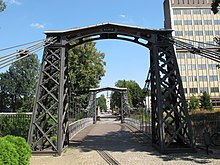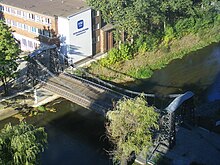Ozimek
| Ozimek Malapane |
||
|---|---|---|

|
|
|
| Basic data | ||
| State : | Poland | |
| Voivodeship : | Opole | |
| Powiat : | Opolski | |
| Area : | 3.25 km² | |
| Geographic location : | 50 ° 41 ′ N , 18 ° 13 ′ E | |
| Height : | 185 m npm | |
| Residents : | 8907 (Dec. 31, 2016) | |
| Postal code : | 46-040 | |
| Telephone code : | (+48) 77 | |
| License plate : | OPO | |
| Economy and Transport | ||
| Street : | DK 46 Kłodzko - Szczekociny | |
| Ext. 463 Bierdzan - Zawadzkie | ||
| Rail route : | Zawadzkie – Opole | |
| Next international airport : | Katowice | |
| Wroclaw | ||
Ozimek [ ɔˈʑimɛk ] ( German : Malapane ) is a city with around 8900 inhabitants and an area of 3.25 km² in the Polish powiat Opolski of the Opole Voivodeship . The city is the seat of the city-and-country municipality of the same name .
geography
Ozimek is located in the historical region of Upper Silesia in the Opole region . The city is located approx. 22 km east of the district capital and voivodeship capital Opole ( Opole ).
The place is in the Nizina Śląska ( Silesian Plain ) within the Równina Opolska ( Opole Plain ). The Mała Panew (Eng. Malapane ), a right tributary of the Oder, flows through the village . About 5 km northwest of the city is the Turawa reservoir .
Two national roads run through Ozimek, including the state road Droga krajowa 46 and the provincial road Droga wojewódzka 463 . The Zawadzkie – Opole railway with the Ozimek stop runs south of the city center .
history

Up until the middle of the 18th century there were dense forests on the site of the present city. After large iron stone deposits were discovered on the Malapane, two blast furnaces were built on the river in 1753 and 1754 on the orders of King Frederick II of Prussia .
Together with the fresh fires in Krascheow (Krasiejów) , Jedlitze (Jedlice) and Dembiohammer (Dębska Kuźnia) , the first state ironworks in Upper Silesia , the Malapane ironworks , emerged from these blast furnaces . From 1780 the place became the seat of a royal steelworks office.
The smelters were recruited from the western provinces of Prussia, for them the colony Hüttendorf (today ulica Wyzwolenia) was built. The construction of the colony, which began in 1762, was headed by the forester Johann Georg Rehdanz , under whose direction the construction of the iron and steel works had already taken place.
The production of cast iron guns in Prussia began in Malapane in 1783. In 1789, attempts were first made on the European continent to use coke for the smelting process in a blast furnace of the plant instead of the previously common charcoal . This led to the construction of a functional, coke-powered blast furnace in the Royal Ironworks in Gleiwitz, which began operations in 1796. The first steam engine in Germany was built by August Friedrich Holzhausen from Ellrich in 1794.
The parts for Germany's first cast-iron bridge , which led in Laasan (Łażany) over the Striegau water , were cast here in 1796.
In 1801 a memorial was erected in Malapane for the chief forester Rhedanz, who died in 1765, based on plans by Karl Friedrich Schinkel . After him was Rhedanz Island named in the Malapane. The Protestant church, built in 1819, also comes from Schinkel.
In addition to the cannon foundry, Malapane was also known for its artificial casting . Examples of this are the 23 m high and 12.5 ton obelisk from Ullersdorf (Ołdrzychowice Kłodzkie) on the Landecker Biele (Biała Lądecka) from 1802 or the chain bridge in Malapane from 1827, which was the first chain bridge in Europe.
In 1829 the forest colony was incorporated into Malapane. With the emergence of the Upper Silesian industrial area , Malapane became one of the largest steel producers in Silesia. The iron casting stopped when the lawn iron ore deposits in the area were mined.
In the referendum in Upper Silesia on March 20, 1921, 164 voters in Malapane voted to stay with Germany and 31 for Poland. In Hüttendorf, 317 people voted for Germany and 51 for Poland. Malapane and Hüttendorf remained with the German Empire .
In 1924 the Hüttendorf colony was incorporated into Malapane. In 1944 the Malapane iron and steel works belonged to the United Oberschlesischen Hüttenwerke AG and employed around 3,000 people.
After the Second World War, the place was named Ozimek . The namesake was a miller whose mill, according to the communist leadership of the time, stood before the construction of the ironworks on the Malapane.
The plant, which was completely dismantled by the Red Army in 1945 , was rebuilt as the Małapanew metallurgical plant and around 1975 employed around 7,000 people. After the end of communist rule in Poland and the opening to international markets, the Ozimek smelter had to stop production in 1989 because it was unable to cope with the competition on the steel market. This marked the end of an almost 250-year-old tradition of iron and steel production in Malapane.
Ozimek since 1954 was an urban settlement and received in 1962 the municipal law .
Population development
1885: 185 inhabitants
1905: 180
1925: 1,131 (including Hüttendorf)
1939: 3,998
1957: 3,500
1961: 3,698
1971: 5,000
Dec. 31, 1995: 10,999
Dec. 31, 2000: 10,479
Dec. 31, 2005: 9,994
politics
Town twinning
On July 11, 1992, the official notarization of the town twinning between Heinsberg ( North Rhine-Westphalia ) and Ozimek took place in the auditorium of the secondary school Heinsberg . “Contacts and exchange programs” were agreed, especially for young people. In the meantime, an open and warm friendship has developed between the two cities. The highlights include the partnership days that take place every two years and are held alternately in Ozimek and Heinsberg.
In 1997 a partnership document was signed between Ozimek and the Czech town of Rýmařov (Roman town) .
There is also a friendship with the Hessian Scotsman .
Attractions
The sights of the city of Ozimek are closely related to industrialization and the local hut.
Chain bridge
The chain bridge on the smelter site spans the Malapane and was cast in the smeltery of the same name in 1827. The construction goes back to machine inspector Schottelius. Today it only serves as a crossing point for pedestrians and is considered the oldest iron chain bridge in Europe.
Protestant church
Only 50 years after its foundation in 1768 did the Protestant parish in Malapane receive its own church. The Protestant St. John's Church was built from 1819 to 1821 according to a design by Karl Friedrich Schinkel . Schinkel created a simple hall building in a round arch style , which was flanked by four turrets and an apse on the east wall . A distinctive decorative and structuring element of the church are the brick frames of the window arches, which contrast with the otherwise plastered exterior. Originally the church only had a free-standing wooden bell tower with two bells. It was not until 1859 that the construction of a front tower above the entrance hall began, which was carried out by master bricklayer Munscheid. In 1860 the church tower with its slim helmet could be inaugurated. Despite the flight and displacement of most of the parishioners as a result of the Second World War, the building still serves as a place of worship for the Evangelical Augsburg parish . Most of the church's precious neo-Gothic interior, cast in the local hut, was burned in 1988.
St. John Baptist
The old parish church of St. Johannes Baptist was built from 1934 to 1935 according to plans by Anton Mokroß on the local border with Schodnia, in the immediate vicinity of the ironworks. As the ironworks expanded, the church became the property of Huta Małapanew in 1978. In return, the parish received a piece of land near the Protestant church, on which today's parish church was built from 1978–1983.
societies
- German Friendship Circle
- KS Małapanew Ozimek football club
- Volunteer fire brigade OSP Ozimek
local community
The urban-and-rural community of Ozimek covers an area of 126.5 km², on which almost 20,000 people live.
Personalities
sons and daughters of the town
- Wilhelm August Stilarsky (around 1780–1838), iron caster
- Karl Richter (1829–1893), coal and steel industrialist
- Paul Wachler (1834–1912), mining clerk
- Franz Gruß (1931–2006), sculptor
- Gerd-Peter Eigner (1942–2017), writer
- Adam Kępiński (* 1975), politician
- Peter Schyrba (* 1980), German soccer player
- Waldemar Sobota (* 1987), football player
- Paweł Olkowski (* 1990), football player
- Paweł Genda (* 1994), handball player
Web links
Individual evidence
- ↑ See results of the referendum in Upper Silesia of 1921 ( Memento of January 24, 2017 in the Internet Archive )
- ↑ See www.parafia-ozimek.pl: Kościół przy Hucie (“Stary Kościół”). , accessed June 19, 2014
- ↑ See www.ozimek.pl: Parafia Rzymsko-Katolicka św. Jana Chrzciciela w Ozimku. ( Memento of the original from February 21, 2014 in the Internet Archive ) Info: The archive link was inserted automatically and has not yet been checked. Please check the original and archive link according to the instructions and then remove this notice. , accessed June 19, 2014
- ↑ Directory of the DFKs on the VdG website ( Memento of the original of November 9, 2012 in the Internet Archive ) Info: The archive link has been inserted automatically and has not yet been checked. Please check the original and archive link according to the instructions and then remove this notice.






